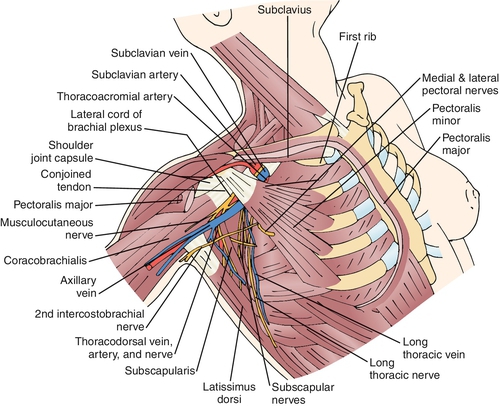CHAPTER 109
Post-Mastectomy Pain Syndrome
Definition
Post-mastectomy pain syndrome (PMPS) is a chronic pain condition, typically neuropathic in nature, that can follow surgery to the breast [1]. PMPS can occur with any surgery to the breast including mastectomy, lumpectomy, reconstruction, and augmentation, although symptoms of post-mastectomy pain are reduced with sentinel lymph node procedures [2,3]. PMPS affects approximately 40% to 52% of patients after breast surgery [3–5]. The risk factors for development of PMPS include younger age, more extensive surgery, more than 15 lymph nodes removed, more immediate postoperative pain, and anxiety [2,4,6]. Within the first 24 hours of surgery, 60% of patients have severe pain [7]. PMPS typically is manifested as phantom breast pain, intercostobrachial neuropathy, or incisional pain. Early management includes pain control, desensitization techniques, and shoulder range of motion. Chronic management includes neuropathic pain agents, interventional procedures, and rehabilitation. Primary objectives of management include sleep preservation, maintenance of shoulder function, and vocational rehabilitation.
Classification of PMPS can be divided into four categories: phantom breast pain, intercostobrachial neuralgia, myogenic pain, and neuroma pain [8]. Phantom pain is identified in 23% of post-mastectomy patients and consists of painful sensations in the area of the removed breast [9]. The intercostobrachial nerve is the lateral cutaneous nerve of the second thoracic root. It courses along the axillary vein and then provides sensation to the axilla and breast (Fig. 109.1). The intercostobrachial nerve is frequently stretched or sacrificed during axillary lymph node dissections and is a common cause of PMPS [8,10,11]. Myogenic pain is common after mastectomy and is associated with surgical irritation and immobilization. The scar from breast surgery can be a generator of pain. The pain has been attributed to underlying neuroma formation, axon impingement, and scar retraction [8,12].

Symptoms
The symptoms associated with PMPS include shooting, stabbing, burning, and pins and needles sensations in the breast, axilla, or medial arm [1,3,8,13–15]. In addition, patients complain of symptoms of tightness and fullness in the axilla. Pain is aggravated by shoulder movement, stretching, straining, and direct contact with clothes [3,13]. The symptoms of PMPS are usually nonprogressive and have been found to persist in half of patients observed for 9 years [1,13]. PMPS results in functional loss and sleep disruption, and these may be common presenting complaints [1,12].







